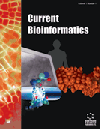- Home
- A-Z Publications
- Current Bioinformatics
- Previous Issues
- Volume 4, Issue 3, 2009
Current Bioinformatics - Volume 4, Issue 3, 2009
Volume 4, Issue 3, 2009
-
-
From DNA Sequence to Plant Phenotype: Bioinformatics Meets Crop Science
More LessAuthors: Primetta Faccioli, Antonio M. Stanca, Caterina Morcia and Valeria TerziPhenotype at crop level is the result of the interaction among many genes whose expression is often dependent on environmental conditions and developmental stage. Multilevel, computer-based, data integration thus plays a fundamental role in the understanding of many important agronomic traits such as yield and resource use efficiencies. Bioinformatics is the key for realizing the full potential of post-genomic revo Read More
-
-
-
A Research on Bioinformatics Prediction of Protein Subcellular Localization
More LessAuthors: Gang Fang, Guirong Tao and Shemin ZhangProtein subcellular localization is one of the key characteristic to understand its biological function. Proteins are transported to specific organelles and suborganelles after they are synthesized. They take part in cell activity and function efficiently when correctly localized. Inaccurate subcellular localization will have great impact on cellular function. Prediction of protein subcellular localization is one of the important areas in prote Read More
-
-
-
Network Models for Dissecting Plant Development by Functional Mapping
More LessAuthors: Song Wu, John S. Yap, Yao Li, Qin Li, Guifang Fu, Jiahan Li, Kiranmoy Das, Arthur Berg, Yanru Zeng and Rongling WuUnderstanding the genetic machinery of plant growth and development is of fundamental importance in agriculture and biology. Recently, a novel statistical framework, coined functional mapping, has been developed to study the genetic architecture of the dynamic pattern of phenotypic development at different levels of organization. By integrating mathematical aspects of cellular and biological processes, functional map Read More
-
-
-
Network Systems Underlying Traditional Chinese Medicine Syndrome and Herb Formula
More LessBy Shao LiTraditional Chinese Medicine (TCM) is characterized by regulating the integrity of the human body and has accumulated thousand-year experience in the use of Herb Formula (“Fu-Fang“ in Chinese) for managing complicated TCM Syndrome (“ZHENG” in Chinese). In recent years, there has been increasing concern about the application of bioinformatics and systems biology approaches for deciphering the scientific basis and the s Read More
-
-
-
An Overview of the De Novo Prediction of Enzyme Catalytic Residues (Supplementry file)
More LessAuthors: Ziding Zhang, Yu-Rong Tang, Zhi-Ya Sheng and Dongbin ZhaoThe identification of catalytic residues of an enzyme is one of the most important steps towards understanding its biological roles and exploring its applications. Thus far, a range of catalytic residue prediction methods have been developed, which play an increasingly important role in complementing the experimental characterization of enzymatic functions. The available approaches can be split into two broad categori Read More
-
-
-
Modular Organization in a Cell: Concepts and Applications
More LessAuthors: Ruolin Yang and Bing SuNetwork biology is conceptualized as an interdisciplinary field, lying at the intersection among graph theory, statistical mechanics and biology. Great efforts have been made to promote the concept of network biology and its various applications in life science. In this review, we focus on the modules that are functional entities and building blocks of a complex network. We first introduce the basic concepts and hot spots of net Read More
-
-
-
Progress onAmpC β-lactamases
More LessAuthors: Jia-Bin Li, Jun Cheng, Jun Yin, Xiao-Ni Zhang, Fan Gao, Yu-Lin Zhu and Xue-Jun ZhangFull text available
-
-
-
Protein Inference by Assembling Peptides Identified from Tandem Mass Spectra
More LessAuthors: Jinhong Shi and Fang-Xiang WuProtein inference is the final but very important step to identify proteins in biological complex from tandem mass spectrometry analysis. Assembling peptides identified from tandem mass spectra is one of the most widely used methods for protein inference in proteomics studies. The “bottom-up” approaches cut off the connection between peptides and proteins and thus significantly complicate the protein inference. Fi Read More
-
-
-
A Novel Method of Studying the Disease Regulatory Activities of MicroRNAs
More LessAuthors: Sanghamitra Bandyopadhyay and Malay BhattacharyyaMicroRNAs (miRNAs) are small, non-coding RNAs that participate in the post-transcriptional regulation of messenger RNAs (mRNAs) by degrading or inhibiting translation. Some of the topical studies strongly suggest that the disorders in the normal activities of miRNAs might cause many diseases. Generally, such studies concern patient-specific expression profiles for the purposes like pruning, clustering or classification. This paper Read More
-
-
-
Microarray Data Analysis to Find Diagnostic Approach and Identify Families of Disease-Altered Genes Based on Rank-Reverse of Gene Expression
More LessAuthors: Wenguang Zhang, Jinquan Li, Rui Su and Wu JianghongMolecular disease mechanisms typically constitute abnormalities in the regulation of genes producing many kinds of alterations in the expression levels. To identify disease-altered genes better, we have developed an approach that searches for the genes which present a significant rank alteration in the rank of their expression profiles, by comparing an altered rank with another gene. The approach provides groups of ge Read More
-
Volumes & issues
-
Volume 20 (2025)
-
Volume 19 (2024)
-
Volume 18 (2023)
-
Volume 17 (2022)
-
Volume 16 (2021)
-
Volume 15 (2020)
-
Volume 14 (2019)
-
Volume 13 (2018)
-
Volume 12 (2017)
-
Volume 11 (2016)
-
Volume 10 (2015)
-
Volume 9 (2014)
-
Volume 8 (2013)
-
Volume 7 (2012)
-
Volume 6 (2011)
-
Volume 5 (2010)
-
Volume 4 (2009)
-
Volume 3 (2008)
-
Volume 2 (2007)
-
Volume 1 (2006)
Most Read This Month
Article
content/journals/cbio
Journal
10
5
false
en


